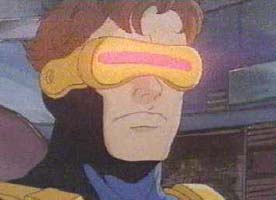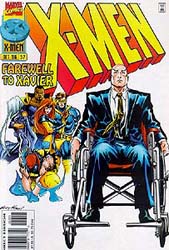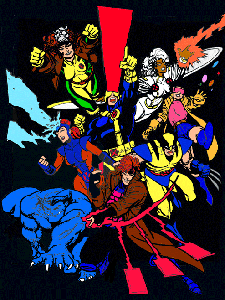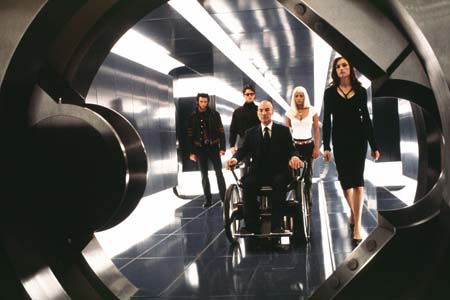|
Ty
Power looks back at the X-Men
nineties animated television series...
Created
in 1963 by Marvel Comics maestro Stan Lee and artist Jack
Kirby, The X-Men didn't really take off in the popularity
stakes until after the first decade. The problem was the setting
rather than the premise.
The
Original X-Men comprised anchor Cyclops (Scott Slim Summers,
who emitted dangerous laser-like rays from his eyes), Iceman
(Bobby Drake, who formed and manipulated ice), Angel (Warren
Worthington the Third, who could fly with huge wings), Beast
(Henry Hank McCoy, with the strength of a gorilla), and introduced
Marvel Girl (Jean Grey, with telekinetic powers later to become
Phoenix). The wheelchair-bound telepath, Professor Charles
Xavier, was their teacher-trainer, nurturing their mutant
abilities. His dream was to have humans and mutants living
peacefully together.
It proved unsuccessful to the young readership to have teenagers
put through such rigorous and dangerous training rituals.
Xavier was regarded as a strict headmaster, and this wasn't
fantasy escapism so much as an unpleasant close reality. When
the situation was realised, the Original X-Men left
to be replaced by adults. However, the Originals shortly returned
as adults.
In
1975 the X-Men received a much needed boost. Marvel
writer Len Wein and artist Dave Cockrum revamped the format
by having all of the Original team except Cyclops resign.
The reasoning was to have several mutants come and go and
therefore keep the ideas fresh. Some characters lasted the
distance: mainstay Cyclops and Wolverine, for instance, whereas
Thunderbird was killed in battle after only a third appearance.
This made for interesting interpersonal upheaval as instability
permeated the ranks.
From
this moment the popularity of the phenomenon became intense.
One major comic release of the early nineties sold in excess
of a staggering eight million copies. During the last few
years, the X-Men has become Marvel's top title, even
out-selling the hugely durable Spider-Man. Into this
yawning chasm of demand for new material came X-Men
the animated series.
The
concept proved difficult to achieve the necessary backing
required to progress. However, once Margaret Loesch discovered
the comics and the potential therein she was determined to
see the characters come alive. Her employers at NBC TV simply
weren't interested an X-Men cartoon. Later, at Hanna-Barbera,
she proved highly successful at launching new material, but
the various networks didn't see a market for the Marvel mutants.
As Marvel president, Loesch produced a pilot episode which
also failed to attract backing. Only when she joined the Fox
Children's Network in 1990 did the project finally reach fruition.
A phone call to Marvel's Stan Lee initiated the launch of
an action-packed series which took the children's television
market by storm (no pun intended!).
It was a four-way collaboration between Fox (with national
television rights), PolyGram - based in the U.K. (with international
home video rights), Marvel Entertainment Group (with merchandising
and worldwide publishing rights), and producers Saban International
Services (controlling international TV rights). Animation
by Graz Entertainment was conducted at Animation Houses: AKOM,
Phillipine, and Hung Ying. As expected, Stan Lee was an Executive
Producer, with Scott Thomas as Supervising Producer, and Dan
Hennessey as Voice Director.
 |
After
much deliberation it was decided to give the audience the
later line-up. The nucleus of Cyclops, Beast (no longer human,
but a blue-skinned animal-like creature), and Jean Grey remained.
Added to these were Wolverine (also seen in his own comics
run, and considerably toned down from the aggressive killer
in the name of justice), Storm (with the unexplainable ability
to manipulate the weather), Rogue (who can absorb the powers
of others things through touch), Gambit (with kinetic energy
abilities), Morph (specially created for the show - but soon
sacrificed to display the magnitude of the youngsters' struggle
- and able to change his appearance to resemble anybody),
and the obligatory newcomer Jubilee (who can shoot plasma
from her fingertips).
The X-Men is set against a believable future society
backdrop wherein humans with mutant abilities are born naturally
at irregular intervals. It is law for parents to register
these births at the Mutant Control Agency, leading to their
collection by robotic Sentinels. In the first two-part story,
Night of the Sentinels, a mighty battle ensues when the team
prevent Jubilee from being taken. She is then drilled on mutants
and their history, before finally becoming a member of the
élite. The X-Men scores high by making a very valid
but prudent point regarding racism. The ultimate objective
is for homo sapiens and homo superiors to live peacefully
together. They seek to stop the persecution by destroying
the Sentinels and bringing to justice those behind them. Ironically,
evil mutants are often utilised against the X-Men.
 |
An
aspect carried forward from the earlier format is the presence
of Professor Xavier as their mentor, although there are many
stories in which he doesn't appear at all. Many earlier characters
make starring appearances throughout the episodes; among these
are: Archangel (originally simply the Angel), Colossus, and
Domino. The main villains of the piece are Magneto (with the
power of magnetism), Juggernaut (a massive, almost unstoppable
powerhouse, and the half-brother of Prof. X), Mojo (a devious
TV executive from a parallel dimension), and Sabretooth (supposedly
a reverse Wolverine, but not too dissimilar).
The
X-Men of this series bare comparison in certain aspects
with two other Marvel creations. Peter Parker of Spider-Man
is an insecure young person who suffers the anguish of everyday
events, even though he possesses special powers. The Fantastic
Four's members bicker almost constantly, particularly the
Human Torch and the Thing, but in reality they are the closest
of companions and know instinctively they can rely on each
other in dire situations. This is the driving force behind
the programme, and the main compulsive element; the inter-character
relationship is everything.
The animation uses the latest elements of the standard age-old
format, although the considerable attention to detail, and
the almost constant action, makes it appear more sophisticated
for a programme targeted primarily at a young audience.
Many
of the classic stories are given the only justice possible
in half an hour. The Dark Phoenix Saga, Days of Future Past,
Birth and Rebirth, and Beyond Good and Evil. Fortunately,
some of these major events are catalogued over several parts,
allowing for the appropriate cliffhangers whilst neatly tying-up
each sub-plot.
 |
The
X-Men's début in America was on 9th January 1993,
four months after its original scheduled start in September
1992, although an isolated episode was tested for the market
during October 1992. In the perpetually tough competition
of the Saturday morning children's spot it went from strength
to strength. In a matter of weeks it took the highest viewing
figures for not only the youngsters age group, but also the
teenagers, who only normally boosted the live-action shows.
Saban attributed the roaring sweep to the gritty, action-orientated
and character driven direction of the show. Fox also reasoned
that the establishment of the fast-growing Fox Kids' Club,
which at that time boasted 7.5 million members, was obviously
a factor, spreading awareness and accelerating promotion.
Advertising is an enormous source of income for any network
hitting the top spot, and the Fox Children's Network is estimated
to have been worth up to $27,000 for only a thirty second
promotion during the X-Men. Contracts were sometimes
arranged and finalised for these brief gaps a year before
airing.
An
initial season of thirteen thirty-minute episodes was produced
at a reported cost of $400,000 each. When these proved successful
beyond all expectation, the trend was continued. To date,
around sixty, spanning four seasons have aired in the US on
Fox. The X-Men was seen over here on Sky One weekdays
at 4:40pm during the mid-nineties and sporadically on terrestrial
TV.
On a final note: One of many projects Marvel Entertainment
is adapting for live-action features is The X-Men 2,
again with Patrick Stewart as Prof. Xavier. The first
X-Men film proved highly successful and paved the way
for a veritable goldmine of Marvel material: Blade, Spider-Man,
Daredevil and The Hulk, with The Fantastic Four,
The Punisher and The Silver Surfer still in their
early stages.

Return
to...

|